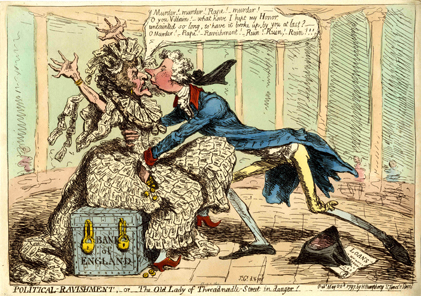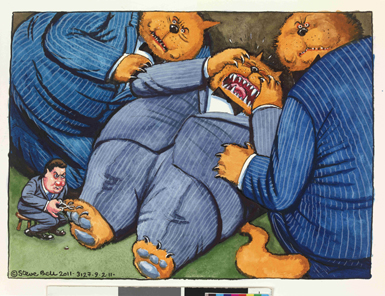January 17, 2013 – In 1890 Punch magazine published a cartoon entitled Same Old Game! in which employees of Barings Bank were depicted as errant schoolboys, having gambled away the bank’s capital through poor investment decisions.
‘The Old Lady of Threadneedle Street in Danger!’ The ‘Old Lady’ is a thin old harridan, dressed entirely in ‘One’ pound notes, and seated on an iron-studded treasure-chest inscribed ‘Bank of England’, fastened by two heavy padlocks; print made by James Gillray; 1797; hand-coloured etching.
In the image they are sheepishly asking the ‘Old Lady of Threadneedle Street’, an allegory for the Bank of England, for a bailout. The Old Lady reluctantly agrees, ‘for this once!!’ Her statement is intentionally ironic – this was not the first financial crisis to affect Britain and it was certainly not going to be the last.
This Coins and Medals display Bubbles and Bankruptcy: financial crises in Britain since 1700, traces the history of financial crisis from the first stock bubbles of the 18th Century through to the current banking crisis. Featuring prospectuses and original share certificates for companies that collapsed, notes from failed banks, and reports about crises. These objects provide a fascinating insight into how and why crises occur. They demonstrate that, in a world of uncertainty, even the most reasoned investment can occasionally fail.
The remainder of the exhibition explores the fertile history of satire and protest about financial crises, represented by historic prints, contemporary cartoons, protest badges and modern works of art. From the works of Dickens to Private Eye magazine, or from the satirical prints of James Gillray …
Bank Levy by Steven Bell; ink and watercolour drawing, UK, 2011; This fat cat is having its claws clipped by the chancellor of the exchequer, George Osborne, in reference to a planned increase in taxation on banks. Depicting bankers as fat cats in suits is a popular theme among satirists.
… to a 2011 cartoon by the artist Steve Bell, there is a remarkable consistency about the way in which people have, and continue to respond to crisis.
Some of the exhibits provide humour but for unintentional reasons. The exhibition features, for example, a congratulatory champagne bottle given out by Northern Rock to its employees in 1997. This was to celebrate the demutualisation of the building society to become a bank. The bottle provides an ironic reminder that demutualisation was supposed to enable Northern Rock to expand its business interests. However, history records that its investment portfolio would fail within ten years, triggering the first bank run on a UK bank since 1866.
House of Cards: Sculpture by Justine Smith, a London based artist entitled ‘House of Cards’; The artist has stacked genuine UK GBP10, GBP20 and GBP50 notes instead of the playing cards, symbols of gambling, that typically make up a house of cards © Justine Smith 2012.
The centrepiece of the exhibition is a contemporary sculpture entitled House of Cards by Justine Smith, a London-based artist. The artist has stacked real UK notes instead of the playing cards, symbols of gambling, that typically make up a house of cards. The artwork neatly symbolises the sometimes precarious nature of financial speculation.
The exhibition in the Coins and Medals room at the British Museum, London, started on November 29, 2012 and will be going on until May 5, 2013. You can find all information about it on the website of the British Museum.
The curator Thomas Hockenhull wrote an article on the display in the British Museum blog.






